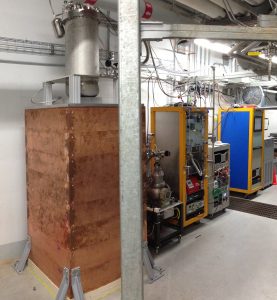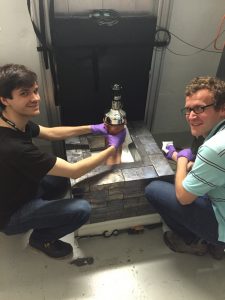Location of Detector Systems in Neutrino Alley
NA virtual tour
Active Systems
Single-Phase LAr Subsystem
Liquid argon (LAr) detectors continue to be instrumental in high energy physics. Efforts to reduce thresholds and inform the LAr detector response are crucial for future WIMP searches, long baseline experiments, and CEvNS measurements.
CENNS-10 is a single phase liquid argon (LAr) detector developed at Fermilab. Two facing PMTs see a 24-kg mass of LAr. It has been operating at the SNS since December 2016 and was upgraded to improve light collection in the summer of 2017. The LAr working group convener is Rex Tayloe.
CENNS-10 poster: ORNLCENNS10Results0120.pdf
Video and poster from Jacob Zettlemoyer for Neutrino 2020, about CENNS-10: JCZNeutrinoVideo.mp4 JCZNeutrino2020CENNS10.pdf
HPGe PPC Subsystem
 The HPGe detector system consists of 18 kg of p-type point-contact germanium detectors. Germanium detectors have very good energy resolution and would be a cross-section between that for the LAr and CsI[Na] detectors. The HPGe working group convener is Matthew Green.
The HPGe detector system consists of 18 kg of p-type point-contact germanium detectors. Germanium detectors have very good energy resolution and would be a cross-section between that for the LAr and CsI[Na] detectors. The HPGe working group convener is Matthew Green.
Long Li, Ge QF: Quenching Factor Measurements for Germanium Detectors at TUNL.pdf
Keith Mann, CEvNS measurements with Ge: CEvNS measurements with Ge.pdf
NaI (TI) Subsystem
A 185-kg NaI[Tl] detector was deployed at the SNS in June 2016. This detector was built to study the neutrino charged-current interaction on iodine-127 and to measure beam-related backgrounds for a CEvNS search using sodium recoils. Plans are underway for a ton-scale deployment that will simultaneously measure these cross-sections. Apart from drastically different energy scales, the charged-current interaction only occurs for electron neutrinos, whereas CEvNS should occur for all flavors of neutrinos. The NaI[Tl] working group convener is Diane Markoff.
Karla Tellez-Giron-Flores, Ton-Scale NaI Presentation/audio, Public Friendly: Virtual_Tour_NaI.pptx (English) Spanish version
Diane Markoff, Ton-Scale NaI: Nton_NaI_Markoff_554.pdf
Video from Sam Hedges for Neutrino 2020, about CC interactions in NaIvE: Electron_Neutrino_Charged-Current_Interactions_on_I-127_in_the_COHERENT_NaIE_Detector.mp4 SHedges_Neutrino2020_Final.pdf
Peibo An: Machine learning for NaI.pdf
MARS Neutron Detector
MARS module has 16 photomultiplier tubes monitoring the signals from interwoven EJ200 scintillator and gadolinium-doped Mylar. Paired analyses are done because the neutron will leave two energy depositions in MARS – it will down-scatter and thermalize in the scintillator, then capture on the gadolinium. It has been deployed to Neutrino Alley since June of 2017, but it was moved to a new location in January 2019. The MARS working group convener is Belkis Cabrera-Palmer.
Rebecca Rapp: Studying neutron backgrounds for COHERENT with MARS.pdf
Video from Duy Hoang for CEU DNP 2020, about MARS simulation: Hoang Duy GA
D2O Subsystem
To benchmark the neutrino flux, a 1300-kg D2O detector is planned to construct in two modules. Each module will consist of an upright cylinder, with D2O contained inside a central acrylic cylinder, contained inside a steel tank with 10 cm of H2O tail catcher. Twelve PMTs view the volume from above.
The heavy water detector system convener is Yuri Efremenko.
D2O paper: https://arxiv.org/abs/2104.09605
Heavy Water Detector Design Review: Heavy Water Detector Design Review.pptx
Karla Tellez-Giron-Flores, D2O detector: A Flux Normalization Detector for the COHERENT Experiment.pdf
NuThor Detector
The NuThor Detector was brought up by Tyler Johnson and deployed in 2022. It is designed to measure neutrino-induced nuclear fission, a phenomenon predicted over 50 years ago but never experimentally confirmed. The core of the detector is composed of 52.0 kgs of thorium-232 metal plates. The thorium target is hermetically sealed inside a neutron multiplicity meter apparatus with two main components: a series of polypropylene water bricks filled with a solution of gadolinium nitrate-loaded water and 36 NaI[Tl] scintillators. A putative neutrino-induced nuclear fission event is observable through multiple neutron-capture gamma rays in rapid succession coincident with the SNS beam pulse.
Planned Systems
CENNS-750
The groundwork for the 610 kg fiducial mass of CENNS-750 detector is laid, to provide precision measurements of the CEvNS cross-section on argon, to probe processes such as the charged-current (CC) response of argon nuclei, and search for accelerator-produced dark matter with unprecedented sensitivity. CENNS-750 will demonstrate the feasibility of a future ~10 t design and mitigate the associated risks, CENNS-750 will already provide competitive preliminary limits on accelerator-produced dark matter.
Ton-scale LAr poster: Poster_LArton_2020Jan.pdf
Video and poster from Ben Suh for Neutrino 2020, about CENNS-750: Ben_Suh_CENNS-750.mp4nuPoster2.pdf
Link to ORNL article about LAr: Compelling evidence of neutrino process opens physics possibilities | ORNL
Cryogenic undoped CsI subsystem
Harnessing the exceptional light output of undoped CsI crystals at cryogenic temperatures, the cryogenic undoped CsI subsystem has the potential to push the energy threshold below 0.5 keVnr, setting a new standard for low-energy particle detection. With this groundbreaking performance, even a compact, 10 kg prototype can deliver world-leading sensitivities in diverse physics investigations, both within and beyond the established Standard Model. The CryoCsI working group convener is Jing Liu.
CryoCsI papers:
Accessing new physics with an undoped, cryogenic CsI CEvNS detector for COHERENT at the SNS
Prospect of undoped inorganic crystals at 77 Kelvin for low-mass dark matter search at Spallation Neutron Source
Prospect of undoped inorganic scintillators at 77 Kelvin for the detection of non-standard neutrino interactions at the Spallation Neutron Source
First operation of undoped CsI directly coupled with SiPMs at 77 Kelvin
Past System
CsI (Na) Subsystem
The CsI[Na] detector was the world’s smallest working neutrino detector at 14.6kg and was operational at the SNS starting in July 2015. The CsI[Na] crystal was shielded with low background materials and has been instrumented with a super-bialkali photo-multiplier tube. The detector was decommissioned in 2019.
Science Magazine – Observation of CEvNS
Neutrino Induced Neutron Detectors
The first neutrino cube was deployed to the SNS in September 2015. It was designed to measure neutrino-induced neutrons (NINs) in lead, which are a background for CEvNS measurements. A second neutrino cube was deployed in February 2017 to search for NINs in Iron. The neutrino cube working group convener is Phil Barbeau.
Jacob Daughhetee, NIN detectors: Neutrino2020_NINsPoster_JD.pdf











